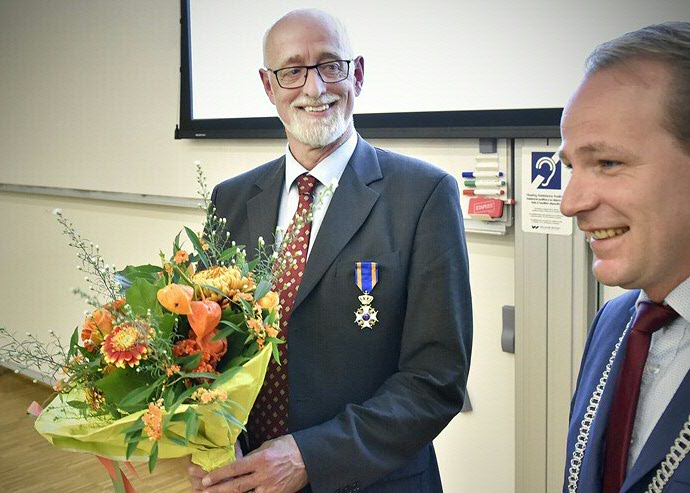Hans van der Plicht appointed Knight of the Order of the Netherlands Lion

On Friday 6 October 2017, after an international symposium to mark his retirement, Prof. Johannes (Hans) van der Plicht has been presented with a Royal Decoration. He has been appointed Knight of the Order of the Netherlands Lion. The presentation has been made by the Deputy Mayor of Groningen Joost van Keulen in the Energy Academy.
Hans van der Plicht (Schiedam, 1951), Professor by special appointment in Isotope Chronology at the University of Groningen, is an internationally renowned scientist who has spent decades working on radiocarbon dating using what is known as the carbon-14 method.
The carbon-14 method
The discovery of the carbon-14 (14C) method, which is used to date organic material of up to approximately 50,000 years old, had a huge impact on archaeological research. It meant that major archaeological discoveries were no longer only made in the field, but also in labs such as the Centre for Isotope Research (CIO) at the University of Groningen, where Van der Plicht was head of the 14C Laboratory. In terms of estimating the value of discoveries and exploring and developing new techniques in the field of archaeology, dialogue with physicists had become essential. Nuclear physicist Van der Plicht was one of the original natural scientists to take a professional interest in archaeological research.
Practical application
Van der Plicht not only understands the finesses of 14C dating, but during his career, he also became an expert in the practical application of the method. He is able to convey the importance of dating and series of dating to non-physicists, including the strengths and weaknesses of the technology. He can indicate whether there is any point to the 14C dating of certain objects, and the expected accuracy of the results: in other words, the age of the objects under investigation. During his career, Van der Plicht acquired so much archaeological knowledge that he was able to give directions about the best way to ‘harvest’ datable material at excavation sites and in museum depots. The confidence he inspired meant that archaeologists, paleoecologists and anthropologists from across the globe asked for his help, and he was involved in countless remarkable discoveries.
Van der Plicht’s unique academic expertise at the interface of natural sciences and archaeology was recognized in 2010 when he was appointed as a member of the Royal Netherlands Academy of Arts and Sciences (KNAW). Interestingly, his appointment was in the department of Literature rather than Natural Sciences. His expertise is also reflected in his double professorship: Van der Plicht is Professor by special appointment in Isotope Chronology in Groningen, and Professor by special appointment in Isotope Archaeology in Leiden.
Golden treasures of the Scythian culture
One of the most memorable datings in Van der Plicht’s career is his work on the golden treasures of the Scythian culture, which are stored in the Hermitage in Saint Petersburg. The treasures, along with various other artefacts that had been excavated, were used for accurate datings of several burial mounds. They also shed new light on the spread and diversity of different Scythian populations across the Eurasian Steppe.
Van der Plicht was an indispensable partner to many Russian colleagues working in Moscow, St Petersburg and Yekaterinburg. For decades, he provided reliable dating of extinct Ice Age fauna, making a vital contribution to Russian Quaternary research. As an ambassador, he was personally responsible for putting the Groningen CIO on the global map, particularly in Russia.
Van der Plicht also made a more personal, revolutionary contribution to science through a research project conducted around Lake Suigetsu in Japan. The sediments on the bed of this lake have been very well preserved. The layers of deposit that have built up over the years contain the preserved remains of plants that grew around the lake, and form the perfect ‘archive’ for 14C determinations. A Japanese postdoc chose Van der Plicht and Groningen to carry out 14C determinations here. This resulted in the first 14C dating going back 45,000 years. The research had global impact, changing insight around the world.
Climate change research
Van der Plicht also played an important part in the application of the 14C method in the search for links between past solar activity and the sun's role in today's climate change. His research oeuvre includes dating at an excavation that found the remains of both Neanderthal and modern man, at excavations of Amstel Castle in Amsterdam, and on the remains of the bones of mammoths, woolly rhinoceros and sabre-toothed tigers found after the ground for Maasvlakte 2 had been raised. These are just some of the highlights from his long and highly productive career.
More recently, Van der Plicht ventured onto ‘biblical’ turf with Professor-Director Mladen Popović of the Groningen Qumran Institute. They are the only people in the world to have been given permission to date snippets of the priceless Dead Sea Scrolls.
These and numerous other collaborations are living proof of the unique role that Van der Plicht has played as a reliable intermediary between the various academic disciplines. He intends to continue his work as a researcher after retirement.
| Last modified: | 12 March 2020 9.33 p.m. |
More news
-
15 April 2025
1.5 million funding from Province of Groningen for innovative technology in the region
The University of Groningen will receive nearly 1.5 million euros in funding from the Province of Groningen to assist entrepreneurial academic researchers in developing innovative ideas into a startup.
-
15 April 2025
Nathalie Katsonis wins Ammodo Science Award 2025
For her pioneering research on molecular systems, Nathalie Katsonis receives the Ammodo Science Award for fundamental research 2025.
-
15 April 2025
Fundamental research with life-size effects
Nathalie Katsonis has won the Ammodo Science Award for Fundamental Research. She develops adaptive molecular materials and studies the chemical origins of life, which in turn yield insights for vaccines and clearing up oil spills at sea.
